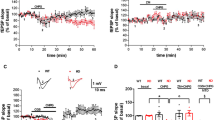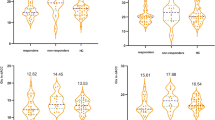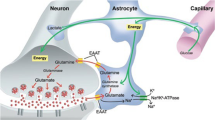Abstract
Recent evidence suggest that antagonism of adenosine A2A receptors represent an alternative therapeutic approach to Parkinson's disease (PD). Coactivation of A2A and the glutamate subtype 5 metabotropic receptors (mGlu5) synergistically stimulates DARPP-32 phosphorylation and c-fos expression in the striatum. This study therefore tested the effects of a joint blockade of these receptors to alleviate the motor dysfunction in a rat model of PD. 6-Hydroxydopamine infusions in the striatum produced akinetic deficits in rats trained to release a lever after a stimulus in a reaction time (RT) task. At 2 weeks after the lesion, A2A and mGlu5 receptors selective antagonists 8-(3-chlorostyryl)caffeine (CSC) and 2-methyl-6-(phenylethynyl)-pyridine (MPEP) were administered daily for 3 weeks either as a single or joint treatment. Injections of CSC (1.25 mg/kg) and MPEP (1.5 mg/kg) separately or in combination reduced the increase of delayed responses and RTs induced by 6-OHDA lesions, while the same treatment had no effect in controls. Furthermore, coadministration of lower doses of 0.625 mg/kg CSC and 0.375 mg/kg MPEP noneffective as a single treatment promoted a full and immediate recovery of akinesia, which was found to be more efficient than the separate blockade of these receptors. These results demonstrate that the combined inactivation of A2A and mGlu5 receptor potentiate their beneficial effects supporting this pharmacological strategy as a promising anti-Parkinsonian therapy.
Similar content being viewed by others
Log in or create a free account to read this content
Gain free access to this article, as well as selected content from this journal and more on nature.com
or
References
Albin RL, Young AB, Penney JB (1989). The functional anatomy of basal ganglia disorders. Trends Neurosci 12: 366–375.
Amalric M, Baunez C, Nieoullon A (1995a). Does the blockade of excitatory amino acid transmission in the basal ganglia simply reverse reaction time deficits induced by dopamine inactivation? Behav Pharmacol 6: 508–519.
Amalric M, Moukhles H, Nieoullon A, Daszuta A (1995b). Complex deficits on reaction time performance following bilateral intrastriatal 6-OHDA infusion in the rat. Eur J Neurosci 7: 972–980.
Anderson JJ, Rao SP, Rowe B, Giracello DR, Holtz G, Chapman DF et al (2002). [3H]Methoxymethyl-3-[(2-methyl-1,3-thiazol-4-yl) ethynyl]pyridine binding to metabotropic glutamate receptor subtype 5 in rodent brain: in vitro and in vivo characterization. J Pharmacol Exp Ther 303: 1044–1051.
Awad H, Hubert GW, Smith Y, Levey AI, Conn PJ (2000). Activation of metabotropic glutamate receptor 5 has direct excitatory effects and potentiates NMDA receptor currents in neurons of the subthalamic nucleus. J Neurosci 20: 7871–7879.
Baja-Jimenez W, Sherzai A, Dimitrova T, Favit A, Bibbiani F, Gillespie M et al (2003). Adenosine A2A receptor antagonist treatment of Parkinson's disease. Neurology 61: 293–296.
Breysse N, Amalric M, Salin P (2003). Metabotropic glutamate 5 receptor blockade alleviates akinesia by normalizing activity of selective basal-ganglia structures in Parkinsonian rats. J Neurosci 23: 8302–8309.
Breysse N, Baunez C, Spooren W, Gasparini F, Amalric M (2002). Chronic but not acute treatment with a metabotropic glutamate 5 receptor antagonist reverses the akinetic deficits in a rat model of parkinsonism. J Neurosci 22: 5669–5678.
Corsi C, Melani A, Bianchi L, Pepeu G, Pedata F (1999). Effect of adenosine A2A receptor stimulation on GABA release from the striatum of young and aged rats in vivo. Neuroreport 16: 3933–3937.
Dawson L, Chadha A, Megalou M, Duty S (2000). The group II metabotropic glutamate receptor agonist, DCG-IV, alleviates akinesia following intranigral or intraventricular administration in the reserpine-treated rat. Br J Pharmacol 129: 541–546.
DeLong MR (1990). Primate models of movement disorders of basal ganglia origin. Trends Neurosci 13: 281–285.
Diaz-Cabiale Z, Meritxell V, Del Arco A, O'Connor W, Harte MK, Müller CE et al (2002). Metabotropic glutamate mGlu5 receptor-mediated modulation of the ventro-pallidal GABA pathway in rats. Interactions with adenosine A2A and dopamine D2 receptors. Neurosci Lett 324: 154–158.
Feeley-Kearney JA, Albin RL (1995). Adenosine A2 receptor-mediated modulation of contralateral rotation induced by metabotropic glutamate receptor activation. Eur J Pharmacol 287: 115–120.
Fenu S, Pinna A, Ongini E, Morelli M (1997). Adenosine A2A receptor antagonism potentiates L-DOPA-induced turning and c-Fos expression in 6-hydroxydopamine-lesioned rats. Eur J Pharmacol 321: 143–147.
Ferré S, Karcz-Kubicha M, Hope BT, Popoli P, Burguen J, Gutierrez MA et al (2002). Synergistic interaction between adenosine A2A and glutamate mGlu5 receptors: Implications for striatal neuronal function. Proc Natl Acad Sci USA 99: 11940–11945.
Ferré S, Popoli P, Rimondini R, Reggio R, Kehr J, Fuxe K (1999). Adenosine A2A and group I metabotropic glutamate receptors synergistically modulate the binding characteristics of dopamine D2 receptors in the rat striatum. Neuropharmacology 38: 129–140.
Fienberg AA, Hiroi N, Mermelstein PG, Song W, Snyder GL, Nishi A et al (1998). DARPP-32: regulator of the efficacy of dopaminergic neurotransmission. Science 281: 838–842.
Fink JS, Weaver DR, Rivkees SA, Peterfreund RA, Pollack A, Adler EM et al (1992). Molecular cloning of the rat A2 adenosine receptor: selective co-expression with D2 dopamine receptors in rat striatum. Molec Brain Res 14: 186–195.
Fredholm BB, Battig K, Holmen J, Nehlig A, Zvartau EE (1999). Actions of caffeine in the brain with special reference to factors that contribute to its widespread use. Pharmacol Rev 51: 83–133.
Fredholm BB, Ijzerman AP, Jacobson KA, Klotz KN, Linden J (2001). Nomenclature and classification of adenosine receptors. Pharmacol Rev 53: 527–552.
Gauntlett-Gilbert J, Brown VJ (1998). Reaction time deficits and Parkinson's disease. Neurosci and Biobehav Rev 22: 865–881.
Grondin R, Bedard PJ, Hadj Tahar A, Gregoire L, Mori A, Kase H (1999). Antiparkinsonian effect of a new selective adenosine A2A receptor antagonist in MPTP-treated monkeys. Neurology 52: 1673–1677.
Halldner L, Lozza G, Lindstrom K, Fredholm BB (2000). Lack of tolerance to motor stimulant effects of a selective adenosine A2A receptor antagonist. Eur J Pharmacol 406: 345–354.
Hauber W, Nagel J, Sauer R, Muller CE (1998). Motor effects induced by a blockade of adenosine A2A receptors in the caudate-putamen. Neuroreport 9: 1803–1806.
Hauber W, Neuscheler P, Nagel J, Muller CE (2001). Catalepsy induced by a blockade of dopamine D1 or D2 receptors was reversed by a concomitant blockade of adenosine A2A receptors in the caudate-putamen of rats. Eur J Neurosci 14: 1287–1293.
Hauser RA, Hubble JP, Truong DD (2003). Randomized trial of the adenosine A2A receptor antagonist istradefylline in advanced Parkinson's disease. Neurology 61: 297–303.
Hillion J, Canals M, Torvinen M, Casado V, Scott R, Terasmaa A et al (2002). Coaggregation, cointernalization and codesensitization of adenosine A2A receptors and dopamine D2 receptors. J Biol Chem 277: 18091–18097.
Jacobson KA, Nikodijevic O, Padgett WL, Gallo-Rodriguez C, Maillard M, Daly JW (1993). 8-(3-Chlorostyryl)caffeine (CSC) is a selective A2-adenosine antagonist in vitro and in vivo. FEBS Lett 323: 141–144.
Jarvis MF, Schulz R, Hutchison AJ, Do UH, Sills MA, Williams M (1989). [3H]CGS 21680, a selective A2 adenosine receptor agonist directly labels A2 receptors in rat brain. J Pharmacol Exp Ther 251: 888–893.
Javitch JA, Strittmatter SM, Snyder SH (1985). Differential visualization of dopamine and norepinephrine uptake sites in rat brain using 3Hmazindol autoradiography. J Neurosci 5: 1513–1521.
Jiang H, Jackson-Lewis V, Muthane U, Dollison A, Ferreira M, Espinosa A et al (1993). Adenosine receptor antagonists potentiate dopamine receptor agonist-induced rotational behavior in 6-hydroxydopamine-lesioned rats. Brain Res 613: 347–351.
Kanda T, Jackson MJ, Smith LA, Pearce RK, Nakamura J, Kase H et al (1998). Adenosine A2A antagonist: a novel antiparkinsonian agent that does not provoke dyskinesia in parkinsonian monkeys. Ann Neurol 43: 507–513.
Kirk IP, Richardson PJ (1994). Adenosine A2A receptor-mediated modulation of striatal [3H]GABA and [3H]acetylcholine release. J Neurochem 62: 960–966.
Koga K, Kurokawa M, Ochi M, Nakamura J, Kuwana Y (2000). Adenosine A2A receptor antagonists KF17837 and KW-6002 potentiate rotation induced by dopaminergic drugs in hemi-Parkinsonian rats. Eur J Neurosci 408: 249–255.
Konieczny J, Ossowska K, Wolfarth S, Pilc A (1998). LY354740, a group II metabotropic glutamate receptor agonist with potential antiparkinsonian properties in rats. Naunyn Schmiedebergs Arch Pharmacol 358: 500–502.
Martinez-Mir MI, Probst A, Palacios JM (1991). Adenosine A2 receptors: selective localization in the human basal ganglia and alterations with disease. Neuroscience 42: 697–703.
Mathiesen JM, Svendsen N, Brauner-Osborne H, Thomsen C, Ramirez MT (2003). Positive allosteric modulation of the human metabotropic glutamate receptor 4 (hmGluR4) by SIB-1893 and MPEP. Br J Pharmacol 138: 1026–1030.
Mayfield RD, Suzuki F, Zahniser NR (1993). Adenosine A2A receptor modulation of electrically evoked endogenous GABA release from slices of globus pallidus. J of Neurochem 60: 2334–2337.
Morelli M, Fenu S, Pinna A, Di Chiara G (1994). Adenosine A2 receptors interact negatively with dopamine D1 and D2 receptors in unilaterally 6-hydroxydopamine-lesioned rats. Eur J Pharmacol 251: 21–25.
Morelli M, Wardas J (2001). Adenosine A2A receptor antagonists: potential therapeutic and neuroprotective effects in Parkinson's disease. Neurotoxicity Res 3: 545–556.
Nishi A, Liu F, Matsuyama S, Hamada M, Higashi H, Nairn AC et al (2003). Metabotropic mGlu5 receptors regulate adenosine A2A receptor signaling. Proc Natl Acad Sci USA 100: 1322–1327.
Ossowska K, Konieczny J, Wolfarth S, Wieronska J, Pilc A (2001). Blockade of the metabotropic glutamate receptor subtype 5 (mGluR5) produces antiparkinsonian-like effects in rats. Neuropharmacology 41: 413–420.
Ouimet CC, Langley-Gullion KC, Greengard P (1998). Quantitative immunocytochemistry of DARPP-32-expressing neurons in the rat caudato-putamen. Brain Res 808: 8–12.
Paxinos G, Watson C (1986). The Rat Brain in Stereotaxic Coordinates, (Edition 2) Academic Press: Sydney.
Pinna A, Di Chiara G, Wadas J, Morelli M (1996). Blockade of A2A adenosine receptors positively modulates turning behaviour and c-fos expression induced by D1 agonists in dopamine-denervated rats. Eur J Neurosci 8: 1176–1181.
Popoli P, Pezzola A, Torvinen M, Reggio R, Pintor A, Scarchilli L et al (2001). The selective mGlu5 receptor agonist CHPG inhibits quinpirole-induced turning in 6-hydroxydopamine-lesioned rats and modulates the binding characteristics of dopamine D2 receptors in the rat striatum. Neuropsychopharmacology 25: 505–513.
Rouse ST, Marino MJ, Bradley SR, Awad H, Wittmann M, Conn PJ (2000). Distribution and roles of metabotropic glutamate receptors in the basal ganglia motor circuit: implications for treatment of Parkinson's disease and related disorders. Pharmacol Ther 88: 427–435.
Schiffmann SN, Jacobs O, Vaderhaeghen JJ (1991). Striatal restricted adenosine A2 receptor (RDC8) is expressed by enkephalin but not by substance P neurons: an in situ hybridization histochemistry study. J Neurochem 57: 1062–1067.
Smith Y, Charara A, Hanson JE, Paquet M, Levey AI (2000). GABA(B) and group I metabotropic glutamate receptors in the striatopallidal complex in primates. J Anat 196: 555–576.
Spooren WP, Gasparini F, Bergmann R, Kuhn R (2000). Effects of the prototypical mGlu(5) receptor antagonist 2-methyl-6- (phenylethynyl)-pyridine on rotarod, locomotor activity and rotational responses in unilateral 6-OHDA-lesioned rats. Eur J Pharmacol 406: 403–410.
Stromberg I, Popoli P, Muller CE, Ferre S, Fuxe K (2000). Electrophysiological and behavioural evidence for an antagonistic modulatory role of adenosine A2A receptors in dopamine D2 receptor regulation in the rat dopamine-denervated striatum. Eur J Neurosci 12: 4033–4037.
Svenningsson P, Le Moine C, Fisone G, Fredholm BB (1999). Distribution, biochemistry and function of striatal adenosine A2A receptors. Prog Neurobiol 59: 355–396.
Svenningsson P, Lindskog M, Rognoni F, Fredholm BB, Greengard P, Fisone G (1998). Activation of adenosine A2A receptor and dopamine D1 receptors stimulates cyclic AMP-dependent phosphorylation of DARPP-32 in distinct population of striatal projection neurons. Neuroscience 84: 223–228.
Tallaksen-Greene SJ, Kaatz KW, Romano C, Albin RL (1998). Localization of mGluR1-like immunoreactivity and mGlur5-like immunoreactivity in identified populations of striatal neurons. Brain Res 780: 210–217.
Testa CM, Standaert DG, Young AB, Penney JB (1994). Metabotropic glutamate receptor mRNA expression in the basal ganglia of the rat. J Neurosci 14: 3005–3018.
Walaas SI, Greengard P (1984). DARPP-32, a dopamine- and adenosine 3′ : 5′-monophosphate-regulated phosphoprotein enriched in dopamine-innervated brain regions. I. Regional and cellular distribution in the rat brain. J Neurosci 4: 84–98.
Wichmann T, DeLong MR (1997). Physiology of the basal ganglia and pathophysiology of movement disorders of basal ganglia origin. In: Watts RL (eds). Movement Disorders: Neurological Principles and Practice. McGraw-Hill: New York. pp 87–97.
Wolfarth S, Konieczny J, Lorenc-Koci E, Ossowska K, Pilc A (2000). The role of metabotropic glutamate receptor (mGluR) ligands in parkinsonian muscle rigidity. Amino Acids 19: 95–101.
Zocchi C, Ongini E, Conti A, Monopoli A, Negretti A, Baraldi PG et al (1996). The non-xanthine heterocyclic compound SCH 58261 is a new potent and selective A2A adenosine receptor antagonist. J Pharmacol Exp Ther 276: 398–404.
Acknowledgements
This research was supported by the Centre National de la Recherche Scientifique, the Fondation de France (MA) and a franco-italian Galilée program by the Ministère des Affaires Etrangères and the CRUI. RC was supported by the CNR (Italy) and NB by the Fondation pour la Recherche Medicale and Institut Lilly. The authors are grateful to Dr Fabrizio Gasparini (Novartis Pharma AG, Basel, Switzerland) for the generous gift of MPEP.
Author information
Authors and Affiliations
Corresponding author
Rights and permissions
About this article
Cite this article
Coccurello, R., Breysse, N. & Amalric, M. Simultaneous Blockade of Adenosine A2A and Metabotropic Glutamate mGlu5 Receptors Increase their Efficacy in Reversing Parkinsonian Deficits in Rats. Neuropsychopharmacol 29, 1451–1461 (2004). https://doi.org/10.1038/sj.npp.1300444
Received:
Revised:
Accepted:
Published:
Issue date:
DOI: https://doi.org/10.1038/sj.npp.1300444
Keywords
This article is cited by
-
Promising biomarkers and therapeutic targets for the management of Parkinson's disease: recent advancements and contemporary research
Metabolic Brain Disease (2023)
-
The mGlu5 Receptor Protomer-Mediated Dopamine D2 Receptor Trans-Inhibition Is Dependent on the Adenosine A2A Receptor Protomer: Implications for Parkinson’s Disease
Molecular Neurobiology (2022)
-
Adenosine A2A receptor inhibition reduces synaptic and cognitive hippocampal alterations in Fmr1 KO mice
Translational Psychiatry (2021)
-
PDZ Scaffold Protein CAL Couples with Metabotropic Glutamate Receptor 5 to Protect Against Cell Apoptosis and Is a Potential Target in the Treatment of Parkinson's Disease
Neurotherapeutics (2019)
-
Group I metabotropic glutamate receptors in the primate motor thalamus: subsynaptic association with cortical and sub-cortical glutamatergic afferents
Brain Structure and Function (2019)



